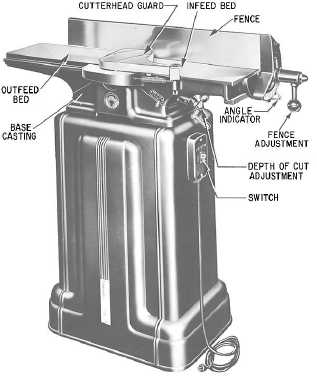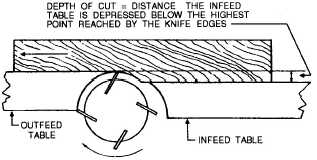
Figure 3-9. - Six-inch jointer.
table an amount equal to the desired depth of cut. The usual depth of cut is about 1/16 to 1/8 inch.
The level of the outfeed table must be frequently checked to ensure the surface is exactly even with the highest point reached by the knife edges. If the outfeed table is too high, the cut will become progressively more shallow as the piece is fed through. If the outfeed table is too low, the piece will drop downward as its end leaves the infeed table, and the cut for the last inch or so will be too deep.
To set the outfeed table to the correct height, first feed a piece of waste stock past the cutterhead until a few inches of it lie on the outfeed table. Then, stop the machine and look under the outfeed end of the piece. If the outfeed table is too low, there will be a space between the surface of the table and the lower face of the piece. Raise the outfeed table until this space is eliminated. If no space appears, lower the outfeed table until a space does appear. Now, run the stock back through the machine. If there is still a space, raise the table just enough to eliminate it.
Note that the cutterhead cuts toward the infeed table; therefore, to cut with the grain, you must place the piece with the grain running toward the infeed table. A piece is edged by feeding it through on edge with one of the faces held against the fence. A piece is surfaced by feeding it through flat with one of the edges against the fence. However, this operation should, if possible, be limited to straightening the face of the stock. The fence can be set at 90° to produce squared faces and edges, or at any desired angle to produce beveled edges or ends.
Only sharp and evenly balanced knives should be used in a jointer cutting head. The knives must not be set to take too heavy a cut because a kickback is almost certain to result, especially if there is a knot or change of grain in the stock. The knives must be securely refastened after the machine has been standing in a cold building over the weekend.
Each hand-fed jointer should be equipped with a cylindrical cutting head, the throat of which should not exceed 7/1 6 inch in depth or 5/8 inch in width. It is strongly recommended that no cylinder be used in which the throat exceeds 3/8 inch in depth or 1/2 inch in width. Each hand-fed jointer should have an automatic guard that covers all the sections of the head on the working side of the fence or gauge. The guard should automatically adjust horizontally for edge jointing and vertically for surface work, and it should remain in contact with the material at all times.
When operating the jointer, observe the following safety precautions:
Always plane with the grain. A piece of wood planed against the grain on a jointer may be kicked back.
Never place your hands directly over the inner cutterhead. Should the piece of wood kick

Figure 3-10. - Operating principle of a jointer.
Continue Reading